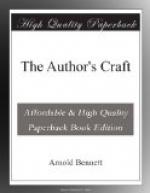The novelist is he who, having seen life, and being so excited by it that he absolutely must transmit the vision to others, chooses narrative fiction as the liveliest vehicle for the relief of his feelings. He is like other artists—he cannot remain silent; he cannot keep himself to himself, he is bursting with the news; he is bound to tell—the affair is too thrilling! Only he differs from most artists in this—that what most chiefly strikes him is the indefinable humanness of human nature, the large general manner of existing. Of course, he is the result of evolution from the primitive. And you can see primitive novelists to this day transmitting to acquaintances their fragmentary and crude visions of life in the cafe or the club, or on the kerbstone. They belong to the lowest circle of artists; but they are artists; and the form that they adopt is the very basis of the novel. By innumerable entertaining steps from them you may ascend to the major artist whose vision of life, inclusive, intricate and intense, requires for its due transmission the great traditional form of the novel as perfected by the masters of a long age which has temporarily set the novel higher than any other art-form.
I would not argue that the novel should be counted supreme among the great traditional forms of art. Even if there is a greatest form, I do not much care which it is. I have in turn been convinced that Chartres Cathedral, certain Greek sculpture, Mozart’s Don Juan, and the juggling of Paul Cinquevalli, was the finest thing in the world—not to mention the achievements of Shakspere or Nijinsky. But there is something to be said for the real pre-eminence of prose fiction as a literary form. (Even the modern epic has learnt almost all it knows from prose-fiction.) The novel has, and always will have, the advantage of its comprehensive bigness. St Peter’s at Rome is a trifle compared with Tolstoi’s War and Peace; and it is as certain as anything can be that, during the present geological epoch at any rate, no epic half as long as War and Peace will ever be read, even if written.
Notoriously the novelist (including the playwright, who is a sub-novelist) has been taking the bread out of the mouths of other artists. In the matter of poaching, the painter has done a lot, and the composer has done more, but what the painter and the composer have done is as naught compared to the grasping deeds of the novelist. And whereas the painter and the composer have got into difficulties with their audacious schemes, the novelist has poached, colonised, and annexed with a success that is not denied. There is scarcely any aspect of the interestingness of life which is not now rendered in prose fiction—from landscape-painting to sociology—and none which might not be. Unnecessary to go back to the ante-Scott age in order to perceive how the novel has aggrandised itself! It has conquered enormous territories even since Germinal. Within




